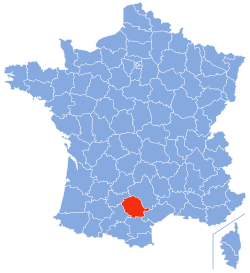Tarn department
| Tarn | |
|---|---|
| Department | |

The old city of Albi and the Tarn river
|
|
 Location of Tarn in France |
|
| Coordinates: 43°49′N 2°12′E / 43.817°N 2.200°ECoordinates: 43°49′N 2°12′E / 43.817°N 2.200°E | |
| Country | France |
| Region | Occitanie |
| Departement | Since 4 March 1790 |
| Prefecture | Albi |
| Subprefecture | Castres |
| Government | |
| • President of the General Council | Thierry Carcenac |
| Area | |
| • Total | 5,757.9 km2 (2,223.1 sq mi) |
| Population (2013) | |
| • Total | 381,927 |
| • Rank | 62 |
| • Density | 66/km2 (170/sq mi) |
| Demonym(s) | Tarnais |
| Time zone | CET (UTC+1) |
| • Summer (DST) | CEST (UTC+2) |
| ISO 3166 code | FR-81 |
| Department number | 81 |
| Arrondissements | 2 |
| Cantons | 23 |
| Communes | 320 |
| Website | http://www.tarn.fr |
Tarn (French pronunciation: [ta:ʁ] or [taʁn]; Occitan: Tarn) is a French department located in the Occitanie region in the southwest of France named after the Tarn river. Its prefecture and largest city is Albi.
The inhabitants of Tarn are known, in French, as Tarnais (women: Tarnaises).
Tarn is one of the original 83 departments created during the French Revolution on 4 March 1790, through application of the Law of 22 December 1789. It was created from part of the former province of Languedoc, and comprised the dioceses of Albi and Castres (which found themselves merged in 1817).
The new department had five districts: Albi, Castres, Lavaur, Gaillac, Lacaune. The capitals (now prefectures) were, alternatively, Albi and Castres but, from 1790 to 1797, the capital was only Albi; in 1797, the capital was moved to Castres.
In 1800, Albi became again the capital of the department and the arrondissements were created; the department had four arrondissements: Albi, Castres, Gaillac and Lavaur. In 1926, the arrondissements of Gaillac and Lavaur were eliminated.
By the law of 28 Pluviôse Year 5, the departments of Hérault and of Tarn exchanged the canton of Anglès (which had been part of the diocese of Saint-Pons, but which has remained in Tarn) for that of Saint-Gervais-sur-Mare (which had been part of the diocese of Castres, but which today remains in Hérault).
...
Wikipedia
